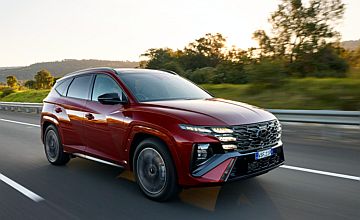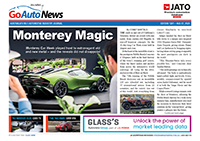Make / Model Search
OptionsCar reviews - Hyundai - Tucson - HybridHyundai modelsResearch Hyundai OverviewWe like Attractive styling inside and out, strong performance, impressive fuel economy, long touring range, gains Bluelink connected car services, hybrid tows up to 1900kg braked Room for improvement Over-the-top SmartSense ADAS technology, pricey in as-tested format, cluttered steering wheel and column controls, e-Dynamic drive too interventionist, evident step-off lag Hyundai’s petrol-electric hybrid Tucson is strong on performance and economy21 Jan 2025 Overview
HYUNDAI revamped its medium-size NX-4 series Tucson SUV mid last year with a focus on a newly available 1.6-litre turbo petrol-electric hybrid powertrain replacing the diesel option. Hybrid tech' is available in higher spec’ FWD and AWD.
The three variant range walk (Tucson, Elite and Premium) also includes a 1.6-litre turbo petrol in FWD and AWD and in the base model only, a 2.0-litre naturally aspirated engine with FWD.
The Atkinson Cycle 2.0-litre and the hybrid both run a conventional six-speed auto transmission while the 1.6-litre turbo uses a seven-speed DCT.
The new Tucson’s external appearance is mildly tweaked as is the interior which features the sexy, wide, curving twin screen display extending across more than half the dash.
The new model gains Hyundai’s Bluelink connected car services with over-the-air upgrade capability and other tech’ enhancements such as Highway Driving Assist (radar cruise control with lane centring).
An optional N-Line pack is available across all variants except the base model bringing a sportier look with dark/black painted body and interior hardware, red highlights, 19-inch wheels, upgraded headlights and upholstery upgrade among other goodies.
Tested here is the top-of-the-range Tucson Premium Hybrid AWD with the N-line pack that retails for more than $60,000 excluding on road costs. It’s a pretty penny for what started out as a small, cheap SUV back in 2004 running through iX35 nomenclature along the way.
The test vehicle’s hybrid powertrain utilises a 1.6-litre, turbocharged, petrol engine assisted by an electric traction motor in the transmission for a combined 172kW and 367Nm. A 1.49kWh battery pumps regen’ harvested electrons into the integrated assist motor.
Claimed combined fuel consumption on 91RON unleaded is 5.3 litres per 100km.
The drive system is predominantly to the front wheels with the rears engaged as needed determined by an array of sensors.
For the not insignificant ask, you get an enhanced safety package that now includes the addition of forward and reverse parking distance warning, crosswind stability control, intelligent speed limit assist, high beam assist, highway driving assist, forward collision avoidance assist, and navigation-based smart cruise control.
Standard equipment includes auto windows up and down, full LED interior lighting, LED front and rear combination lights, head-up display, smart key with push start, 12.3-inch instrument cluster and 12.3-inch multimedia screens, 18-inch alloys, leather, dual-zone climate control, and a column-mounted transmission selector.
The hybrid gains E-Motion Drive that networks a bunch of so-called “E” systems to minimise pitching over speed bumps and control the powertrain for smoother acceleration, optimise traction during corning, reduce slip and improve steering responsiveness.
The paddle shift on the test vehicle controls regenerative braking as well as gear selection with four energy recuperation levels available with the test model offering Terrain mode with Snow, Mud, and Sand settings.
Driving Impressions
We like the look and the size of the new Tucson and especially its fuel economy. On test, we came close to achieving 5.8 litres per 100km.
We like the clean and functional interior highlighted in the wide, curved screen and stepped dash that contains a bank of hard buttons for often used functions which we think should be generically adopted in all new cars… It’s simple to use, good to look at, and probably inexpensive to make.
As Tucson is a five-seater with a relatively large passenger compartment, plenty of room is afforded to all occupants with a good size load space down the back. Critical measurements are generous except for somewhat restricted headroom in the front passenger seat which doesn’t offer the same adjustment range as the driver’s seat.
The firm seats are comfy enough and don’t detract on longer distance travel.
Creature comforts inside the test model were impressive… the premium audio, efficient multi outlet climate control, easy access to seating - all get a tick, but we have yet to warm to the gear selector on the right of the steering column as it is too close to the paddle shift and indicator stalk.
Driving the model is facilitated by a heads-up display, paddle shift and multiple drive modes including a modicum of potentially semi-off-road calibrations.
Despite the hybrids weight at around 1900kg it delivers the same or better all-round performance than the non-hybrid 1.6-litre turbo petrol which weighs considerably less.
The Tucson hybrid feels taut in turns steers fairly quickly, resists bump steer and soaks up large road irregularities smoothly despite having low profile, 19-inch tyres. That would be as a result of the suspension calibration that has been set for Aussie driving conditions by the factory based on intel’ gathered here over decades.
We like the fact that it’s a HEV and not a plug in because it skirts a layer of annoyance plug in EV owners must deal with and you still get access to one pedal driving.
But the turbo doesn’t spool instantly, and the electric motor can’t cover it leading to some lag when you move off the mark or hit the throttle coming out of a corner. It’s like 1001, 1002 bang and may be due to the E-Motion drive parameters.
Once on the move, performance is strong offering up quick overtaking, easy loping roll-on acceleration and plenty of kick for uphills (and presumably) towing.
But we hold reservations for towing the full 2000kg with this car as it may be asking too much of all the electronic systems, small capacity ICE motor and the monocoque chassis.
There are no complaints about the conventional six speed fluid auto, either.
We suffered the usual ADAS intrusions to a point but eventually had enough of the incessant drive speed monitor beeping away and the steering wheel being reefed one way or the other by itself… so we turned it off and became proficient at the two-minute procedure to turn it all off every time we started the car.
After complaints, Hyundai has made the speed monitor system that gives an interminable commentary on your driving, mutable through a favourites button. We’d like to see that extended to cover any ADAS function the driver isn’t comfortable with.
Tucson is now about the same size as a previous model Santa Fe which partially offsets the recent range wide price hike. It’s a good thing, handsome, well equipped, safe, goes well and economical… and you don’t have to plug it in to enjoy electrified driving benefits.
 Read more23rd of July 2024  2024 Hyundai Tucson Hybrid ReviewIs the Tucson Hybrid good enough to challenge the dominant Toyota RAV4? We find out…17th of July 2024  Can Hyundai’s Tucson beat Toyota’s RAV4?Toyota’s segment leading RAV4 faces strong competition from updated Hyundai Tucson Hybrid15th of July 2024  Revised Tucson arrives with hybrid optionHyundai continues electrification program with new 17-variant Tucson Hybrid line-upAll car reviews Alfa Romeo Alfa Romeo Abarth Abarth Audi Audi Aston Martin Aston Martin BMW BMW Bentley Bentley Chrysler Chrysler Chevrolet Chevrolet Dodge Dodge Citroen Citroen Ferrari Ferrari DS DS Ford Ford Fiat Fiat FPV FPV Foton Foton Haval Haval Great Wall Great Wall Honda Honda Holden Holden Hyundai Hyundai HSV HSV Isuzu Isuzu Infiniti Infiniti Jaguar Jaguar Iveco Iveco Kia Kia Jeep Jeep Land Rover Land Rover Lamborghini Lamborghini Maserati Maserati Lexus Lexus McLaren McLaren Mazda Mazda Mercedes-Benz Mercedes-Benz Mitsubishi Mitsubishi Mini Mini Opel Opel Nissan Nissan Porsche Porsche Peugeot Peugeot Ram Ram Proton Proton Rolls-Royce Rolls-Royce Renault Renault Skoda Skoda Saab Saab SsangYong SsangYong Smart Smart Suzuki Suzuki Subaru Subaru Toyota Toyota Tesla Tesla Volvo Volvo |
OptionsClick to share
|











Facebook Twitter Instagram